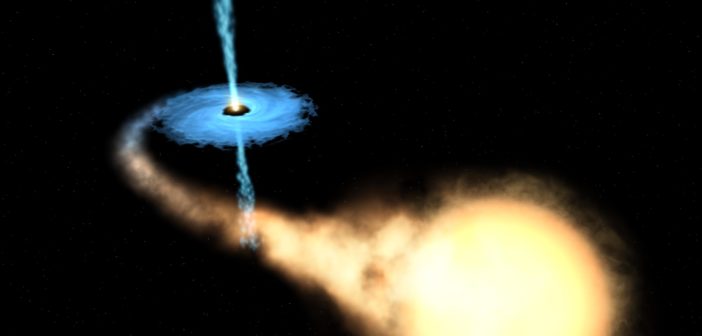An X-ray telescope recently installed on the International Space Station has been improving our view of distant high-energy sources, one object at a time. Now, this telescope has provided a detailed look at a black hole feeding off its companion star.
How to Spot Black Holes
Stellar-mass black holes lurk throughout our galaxy — but their darkness makes them understandably difficult to spot. Because these small beasts don’t emit light, we have few observations of the stellar-mass black holes around us, limiting what we can learn about these mysterious objects and their behavior.
One way that we can observe such black holes is if they exist in an X-ray binary, a binary consisting of a black hole and a donor star. In X-ray binaries, material that is siphoned off the donor star goes to feed the black hole, forming an accretion disk around the black hole as it falls in. As the material in the accretion disk spirals inwards, it radiates strongly in X-rays — resulting in emission that we can observe, even though the black hole itself emits no radiation.But what is the structure of this accretion disk? How far in toward the black hole does it extend? How fast does the black hole spin at its center? These are among the many questions to which scientists are still seeking answers. In a new study, astronomer Jon Miller (University of Michigan) and collaborators present new views of an X-ray binary that may provide some clues.

Spectrum of MAXI J1535−571, fit with a simple disk blackbody plus power-law model. The additional features visible in the data/model ratio are likely due to reflection from the disk. [Miller et al. 2018]
Eyes on a New X-Ray Source
Miller and collaborators present new observations of the X-ray binary MAXI J1535-571 made with the Neutron Star Interior Composition Explorer (NICER), an X-ray telescope recently installed on board the International Space Station.
NICER’s observations indicate that the black hole in this binary is likely spinning very rapidly — at more than 99% of the maximum possible speed! The light we observe from MAXI J1535-571 appears to include contributions both from the black hole’s accretion disk and from the corona of very hot gas that lies above the disk. Light from the corona reflects off of the accretion disk, providing us with more information about the structure of the disk.
By modeling the observations, Miller and collaborators show that the disk extends nearly all the way inwards to what’s known as the innermost stable circular orbit, the closest stable orbit you can have to a black hole.
Reflections of a Warp

Artist’s impression of a example warped disk of gas and dust surrounding a black hole. [James Gitlin (Space Telescope Science Institute)]
The presence of this potential warp, the extent of the disk, and the spin of the black hole are all pieces of the puzzle that will help us better understand the behavior of stellar-mass black holes feeding off of companions. And we can look forward to the high sensitivity of NICER — which made these observations possible — continuing to produce exciting results in the future!
Citation
J. M. Miller et al 2018 ApJL 860 L28. doi:10.3847/2041-8213/aacc61


3 Comments
Pingback: Un agujero negro en giro rápido y con un disco alabeado – Observatori Astronòmic
Pingback: Julio 2018 – Observatori Astronòmic
Pingback: Un agujero negro en giro rápido y con un disco alabeado « SEDA / LIADA - RedLIADA - Cursos LIADA - Cielo del Mes - Fenómenos Astronómicos - RELEA